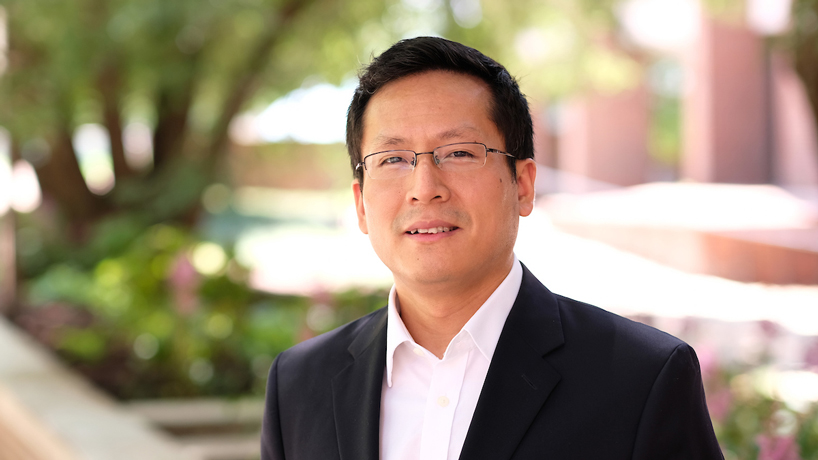
The Bar Association of Metropolitan St. Louis honored Associate Professor Jianli Pan and doctoral Jianyu Wang with its Inventor of the Year Award for their work using blockchain and smart contracts to make Internet of Things devices less vulnerable to attack. (Photo by August Jennewein)
Increasingly, the gadgets and appliances people use most often in their everyday lives are linked via the internet.
There are smart televisions hanging on the walls of a growing number of homes while smart refrigerators store perishable items in the kitchen, smart speakers play music or answer simple questions, smart thermostats adjust the temperature and smart doorbells and door locks await guests who arrive on the front stoop.
“Big companies are investing a lot in the future, and we could have smart homes, smart transportation, even smart agriculture,” said Jianli Pan, an associate professor of computer science at the University of Missouri–St. Louis. “Everything can be smarter.”
While those devices and emerging technologies are celebrated for the ease and convenience they provide their users, Pan said they can also open people up to a growing array of cybersecurity threats with more to secure. Their presence can create blind spots and vulnerabilities that weaken the overall security of important and often sensitive information.
In fact, Internet of Things devices have been at the center of some of the biggest distributed denial of service attacks in recent years.
Pan researches these issues and has been working to invent solutions to improve their security.
“With IoT devices, usually people don’t set the password very carefully,” Pan said. “They set a default password or they set it as 1234, so it can be easily compromised by hackers and turned into a botnet.
“And these devices aren’t like your smartphone, where from time to time you have to update the software. With these IoT devices, it’s not like that automatic thing. So many devices you buy on Amazon for like $20 or $30, nobody cares to manage it. It’s not worth the manpower to keep them updated and accountable.”
A Unit 42 report in 2020 found that 98 percent of all IoT device traffic is unencrypted, “exposing personal and confidential data on the network and allowing attackers the ability to listen to unencrypted network traffic, collect personal or confidential information, then exploit that data for profit on the dark web.” It also revealed that “57 percent of IoT devices are vulnerable to medium- or high-severity attacks, making IoT the low-hanging fruit for attackers.”
Pan and his students, including PhD candidate Jianyu Wang, have developed a way to use blockchain technology and smart contracts to help harden security for IoT devices.
“It’s automatic policy enforcement,” Pan said. “No manual intervention is needed. We deploy the smart contract up front. It’s like a contract between these devices and the owner. It says you have to obey these rules or you have to follow these rules. Whenever these devices try to do some malicious things, it will automatically penalize them or block them.”
Using blockchain is a way to create accountability because it keeps an encrypted record of the activities and transactions in which devices are involved.
In November, the Bar Association of Metropolitan St. Louis honored Pan and Wang with its Inventor of the Year Award for the technology.
Pan and Wang started developing it together in 2018, and Tamara Wilgers, the director of technology commercialization and economic development in UMSL’s Office of Research Administration, caught wind of the work when Wang presented at a research fair.
Wilgers saw the potential and approached Pan and Wang to see if they were interested in pursuing a patent for it.
It was around that time that ORA named Pan its Junior Faculty Investigator of the Year and provided some additional funding to support his research.
Pan and Wang had help from former UMSL undergraduate student Austin Hester in creating a prototype, and Wilgers guided them through the process, first helping them apply for provisional patents as they continued to refine the technology.
She helped connect them with intellectual property attorneys Kevin Kercher and Thaddeus Blenke of Thompson Coburn LLP to handle the legal documents for the filings.
It was Kercher and Blenke who ended up nominating Pan and Wang for the Bar Association’s Inventor of the Year Award. As winners, they are scheduled to be featured in this month’s issue of St. Louis Lawyer Magazine.
“It’s good to see they’re happy with our technology, and they see the potential in it,” Pan said. “It’s a great thing.”
The full patent is on track to be finalized early this year.
Pan and Wilgers are working on a licensing agreement with an investor from Kansas City about the invention.
Pan never anticipated that the work that started three years ago would produce a result that would end up being commercialized. But he’s grateful to Wilgers, Kercher and Blenke and Vice Chancellor for Research and Economic and Community Development Chris Spilling for their help in making it happen.














